This is a Rollei 35RF, a 35mm rangefinder camera made in Japan by Cosina Co., Ltd. for Rollei Fototechnic starting in 2002. The Rollei 35RF has a sister camera also made by Cosina called the Voigtländer Bessa R2, with almost the same specifications, other than different cosmetics and a slightly different viewfinder. The Rollei 35RF uses the Leica M-mount and has a modern vertically traveling focal plane shutter with top 1/2000 and a Silicon Photo Diode TTL meter with match LED display in the viewfinder. It was sold as a premium alternative to the Leica M-series, and despite the Rollei name, is entirely a Japanese camera. Despite being very similar to the previously mentioned Bessa R2, it had a much higher retail price and therefore sold very poorly. Although a terrific camera with excellent build quality, few were made and they are difficult to find today.
Film Type: 135 (35mm)
Lens: 50mm f/1.3 MS-Optics Sonnetar coated 5-elements in 4-groups
Lens Mount: Leica M-Bayonet
Focus: 0.8 meters to Infinity (Rangefinder Coupled)
Viewfinder: Coincident Image Coupled Rangefinder
Shutter: Vertically Traveling Metal Focal Plane
Speeds: B, 1 – 1/2000 seconds
Exposure Meter: TTL SPD Meter w/ Viewfinder Match LED
Battery: (2x) 1.5v LR44 Button Cell Battery
Flash Mount: Hot shoe and PC Terminal with M and X Flash Sync, 1/125 X-Sync
Other Features: Adjustable Framelines and Optional T-Winder Coupling
Weight: 576 grams, 445 grams (body only)
Manual: https://www.cameramanuals.org/rolleiflex/rollei_35_rf.pdf
How these ratings work |
The Rollei 35RF is an uncommon variant of the Cosina made Voigtländer Bessa R2, produced for Rollei and designed for an all new version of the Zeiss Sonnar 40mm f/2.8 lens formerly offered on the Rollei 35 compact camera from the 1960s and 70s. As a modern day 35mm rangefinder, it uses the Leica M-mount, has an excellent and very bright coupled rangefinder and viewfinder with excellent brightness and contrast. It also benefits from a match needle LED display in the viewfinder and a modern metal blade focal plane shutter with a top speed of 1/2000. The build quality, balance, and ergonomics of the camera are excellent and when paired with one of many excellent Leica M-mount lenses, is capable of outstanding photographic images. | ||||||
| Images | Handling | Features | Viewfinder | Feel & Beauty | History | Age | |
| 2 | 2 | 2 | 2 | 2 | 1 | 0% | |
| Bonus | +1 for overall excellence, the complete package | ||||||
| Final Score | 12.0 | ||||||
History
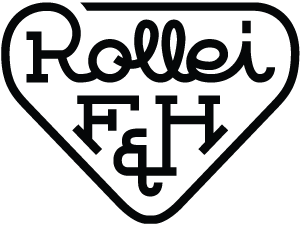 The name “Rollei” is a brand of cameras that throughout a large portion of the 20th century was short for Rolleiflex, an extremely popular brand name of Twin Lens Reflex cameras that shot either 6cm x 6cm images on 120 roll film or 4cm x 4cm images on 127 roll film. The Rolleiflex was originally created by a German company called Franke & Heidecke and was founded in 1920 by two men named Paul Franke and Reinhold Heidecke. Paul Franke was a former employee of another German optics company called Voigtländer who decided to start his own company to produce new camera designs which his former employer showed little interest in.
The name “Rollei” is a brand of cameras that throughout a large portion of the 20th century was short for Rolleiflex, an extremely popular brand name of Twin Lens Reflex cameras that shot either 6cm x 6cm images on 120 roll film or 4cm x 4cm images on 127 roll film. The Rolleiflex was originally created by a German company called Franke & Heidecke and was founded in 1920 by two men named Paul Franke and Reinhold Heidecke. Paul Franke was a former employee of another German optics company called Voigtländer who decided to start his own company to produce new camera designs which his former employer showed little interest in.
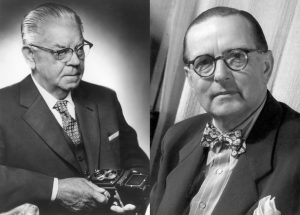
Franke & Hedecke’s first product was a triple lens stereo camera called the Heidoscop which had two lenses for making photos and a third lens for a large waist level viewfinder needed to compose an image. The stereo Heidoscop made stereo images on 45mm x 107mm plates. The camera proved to be very popular, remaining in production from 1921 to 1934. A larger version of the camera which used larger 60mm x 130mm plates remained in production until 1940.
In 1926, a version of the Heidoscop was made which used roll film instead of plates and produced twin 6cm x 6cm on 117 format roll film. The roll film version of the camera was called the Rolleidoscop and was the company’s first use of the prefix “Rollei” in a camera. Also like the larger Heidoscop, a smaller version of the Rolleidoscop was made for 127 format roll film, shooting 4cm x 4cm images.
With the popularity of the roll film Rolleidoscop and its large 6cm x 6cm stereo images, in 1928 Franke & Heidecke started production on a single frame version which they called the Rolleiflex. The name Rolleiflex comes from combining the “Rollei” prefix with “-flex” from “reflex” which was a popular style of camera which describes the use of a mirror in the viewfinder to preview an upright version of the image that will be captured on film. Shortly after the release of the Rolleiflex, a less featured and more economically priced version called the Rolleicord would go on sale, and despite having a different name and being considered a totally different model, would still be collectively referred to as a “Rollei”.
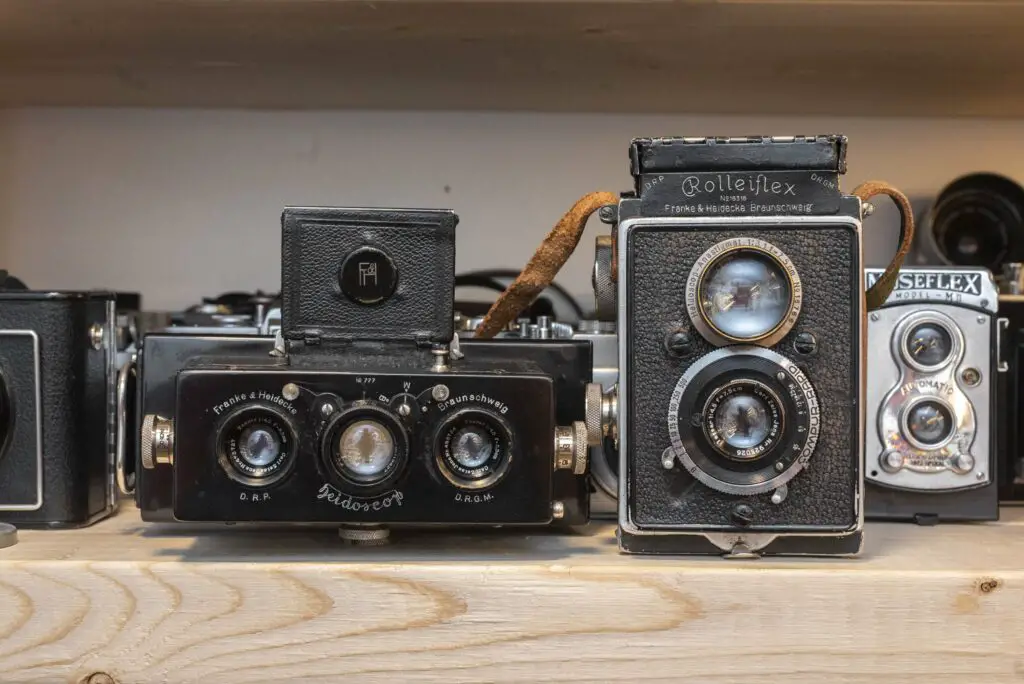
The Rolleiflex was an immediate success and quickly became one of the most popular cameras in both Germany and the world. A huge number of German and later Japanese, American, and Soviet companies would release their own versions of the Rolleiflex, some outwardly copying the design, others, such as Voigtländer, the very company that Paul Franke used to work for, would create all new designs like the Voigtländer Superb that looked very different, but worked the same way.
Throughout the 1930s, during World War II, and to the start of the 1950s, the Rolleiflex, Rolleicord, and Rollei copies would be the preferred camera of professional photographers. If you’ve seen any photos of a historical event taken during or shortly after World War II, there is a very good chance it was taken with a Rollei.
In the 1950s, the popularity of the Rolleiflex and medium format cameras in general would start to wane. More capable 35mm rangefinders such as the Leica, Zeiss-Ikon Contax, Kodak Retina, and Argus C3 started to gain popularity, outselling the Rolleiflexes. Although no longer a dominant maker of professional cameras, Franke & Heidecke would continue producing better and better models, some with faster f/2.8 lenses, dedicated wide angle and telephoto lenses, a model capable of auto exposure, and even an underwater housing allowing the Rolleiflex to be used underwater. These new models were good enough to keep the company going for a little while, but changes in the buying habits of consumers, along with the rise of the Japanese photo industry, plus the death of Reinhold Heidecke in 1960 caused great financial struggles for the company.
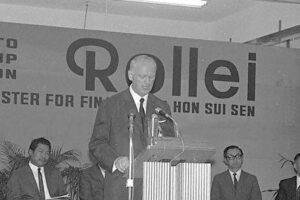
In 1962, the company would reorganize and change its name to Rollei-Werke Franke & Heidecke and two years after that would seek the advice of outside sources. A 38 year old German physicist named Heinrich Peesel, produced a detailed report of where he thought the company should head which impressed Rollei leaders so much, that he was offered a position as Chairman of the Rollei board of directors.
Peesel’s approach was aggressive and involved a complete 180 of the company’s direction from medium format TLRs into several other markets to which the company had little to no experience. It is said that Peesel reviewed a large number of ideas for new products that the company had thought up, and of those, only three were built – a Rolleiscop slide projector, a medium format 6×6 SLR called the SL66 which competed with the Hasselblad 500C, and a 35mm miniature camera called the Rollei 35.
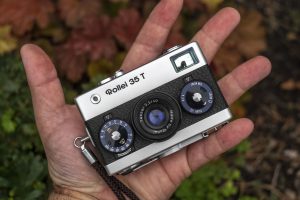
At first, Peesel’s aggressive plan seemed to be working. Investors and customers were excited about the new products, and upon its debut at the 1966 Photokina, the Rollei 35 was the smallest full frame 35mm in the world. Sales immediately flourished and the company began a period of expansion into larger factories and hired more employees anticipating great demand.
After the release of the Rollei 35, Heinrich Peesel held a meeting with the design team at Rollei and declared that their next project must be a 35mm SLR camera. It is said that in this meeting, Peesel brought with an Asahi Pentax Spotmatic because he was so impressed with the quality, compact design, and controls of the Japanese camera that he wanted it to be the basis for Rollei’s new camera.
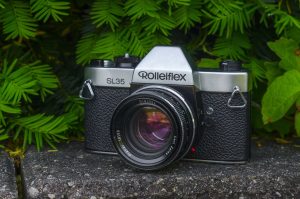
In 1970, Peesel would get his camera, a 35mm SLR called the Rolleiflex SL35. The new SLR succeeded in mimicking the Spotmatic’s compact size and good ergonomics. At a glance, the two cameras were nearly the same size, shared similar rounded corners (as opposed to the sharp corners favored by many Japanese models), had a similarly shaped prism, had flash contacts in the same location, and in the case of chrome models, had similar looking black shutter speed and rewind knobs.
It succeeded in being built to the high standards of quality that customers expected from a camera bearing the Rolleiflex name. Unfortunately, with the limited resources afforded to its designers, the Rolleiflex SL35 lacked several modern features that customers expected at the time, such as open aperture TTL metering, automatic exposure, and full (or partial) information viewfinders. Using the built in meter required the use of a separate button next to the shutter release which would stop down the lens and take a meter reading. The photographer would have to press this button to use the match needle system, get the exposure right, and then move his or her finger over to the separate shutter release button to expose an image. The viewfinder, although bright and easy to see through, lacked any information about the selected shutter speed or aperture values. These characteristics were status quo when the Spotmatic first made its debut in 1964, but by 1970, customers expected more, especially for a camera with a premium price tag like the SL35.
The SL35 sold poorly and in an effort to reduce its cost, in 1973 would see its production moved from Germany to a factory in Singapore which Rollei had leased. Although this did help to lower the price of the camera, sales were still poor. Revised models such as the Rolleiflex SL35M, SL35ME, and SL35E would all be produced with increased automation and a simplification of controls, but none made a major dent in the photographic industry.
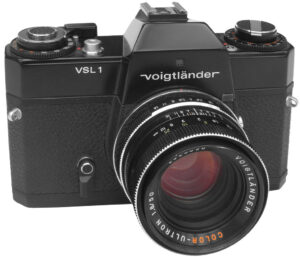
During the 1970s, Rollei wasn’t the only German optics company to struggle. In 1972, Zeiss-Ikon would go through a corporate reshuffle and completely exit the camera make business, selling off their interest of Voigtländer which they had acquired in 1964. Rollei would purchase Voigtländer from Zeiss-Ikon with the hope that a diversification could improve sales. The sale of Voigtländer badged versions of Zeiss-Ikon and Rollei designed SLRs, some with a bayonet mount, and others with the M42 screw mount did little to change the company’s fate, and in 1981, Rollei would discontinue all 35mm SLRs, instead focusing on their slow moving, but slightly profitable medium format.
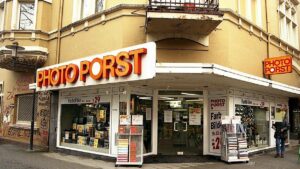
Around the same time as Rollei’s 35mm exit, the company would be sold to Hannsheinz Porst who owned his own retail photo company called Photo Porst. This move was seen as a desperation move as Porst was already struggling financially. In an effort to use the acclaimed Rollei name to boost his sales, Porst discontinued many of Rollei’s products, focusing entirely on basic 35mm viewfinder cameras, and a few medium and high end Rolleiflex models.
The Porst era would not last long as support from consumers and the rest of the industry was non-existent. As a result, less than a year later, the assets of Rollei were liquidated and various parts of the company were sold off to various sources.
At this point, the company that once was maker of world class cameras ceased to exist. The names, trademarks, and technologies owned by Rollei were split up, sold, bought, split up again, and reformed multiple times. One of the new companies created during this era of constant change was Rollei Fototechnic GmbH a name that would follow them over the next couple of decades. Following Rollei Fototechnic GmbH’s history after 1982 is both confusing and depressing, but if you’d like to learn more, Wikipedia’s Rollei article has a lot of detail about the various ownership changes and struggles the company had and would continue to have, you can read about it there.
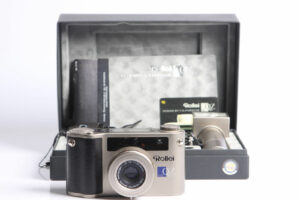
Things began to turn around in 1995 when a majority of Rollei’s assets were purchased by Samsung Techwin, a part of the South Korean conglomerate Samsung Group. Although Samsung’s ownership of the company only lasted 4 years, Samsung did manage to reintroduce the Rollei name by selling a variety of Samsung produced, but Rollei branded cameras to the market. One such model was premium, titnaium bodied Rollei QZ 35W and 35T point and shoot models. This brought in enough revenue such that in 1999, Rollei’s assets were purchased by a group of former Rollei Fototechnic GmbH employees, and in 2002 would be acquired once again by Capitellum A/S, a Danish investment company based in Copenhagen.
In 2002, intrigued by the potential of rebranded premium cameras sold with the Rollei name, at that year’s Photokina, the current version of Rollei would announce a premium 35mm rangefinder called the Rollei 35 RF. The name Rollei 35 was chosen to elicit memories of the last premium Rollei camera, the Rollei 35 from the 1960s and 1970s. Despite the similar name, the new Rollei 35 would be completely unrelated to the original, featuring a much larger body, interchangeable Leica M-mount, a coupled rangefinder, focal plane shutter with top 1/2000 shutter speed, and a through the lens CdS exposure meter with match LED capability.
The new Rollei 35 RF would not be made in Germany or Singapore, but would instead be built the Japanese company, Cosina. Cosina had a long history of building cameras to be rebadged for a huge number of other companies. Models sold by Nikon, Canon, Olympus, Minolta, and a huge number of other companies.
In 1999, Cosina would purchase partial rights to the Voigtländer name from Ringfoto GmbH & Co, a group of German retailers who specialized in the manufacture and distribution of photographic goods. Ringfoto would still retain ownership of the Voigtländer brand, but would allow Cosina to produce cameras using the name. Under the new agreement, Cosina would release a lineup of interchangeable lens Voigtländer Bessa cameras. Most Cosina Bessa cameras would have a coupled rangefinder and would use either the Leica M-bayonet mount, Leica Screw Mount, or the Contax bayonet mount. Cosina’s Voigtländer Bessas were considered by many to be “modern classics”, faithful recreations of new cameras in the style of classic rangefinder cameras. The Cosina built Bessas would be very popular, remaining in production from 1999 to 2015.
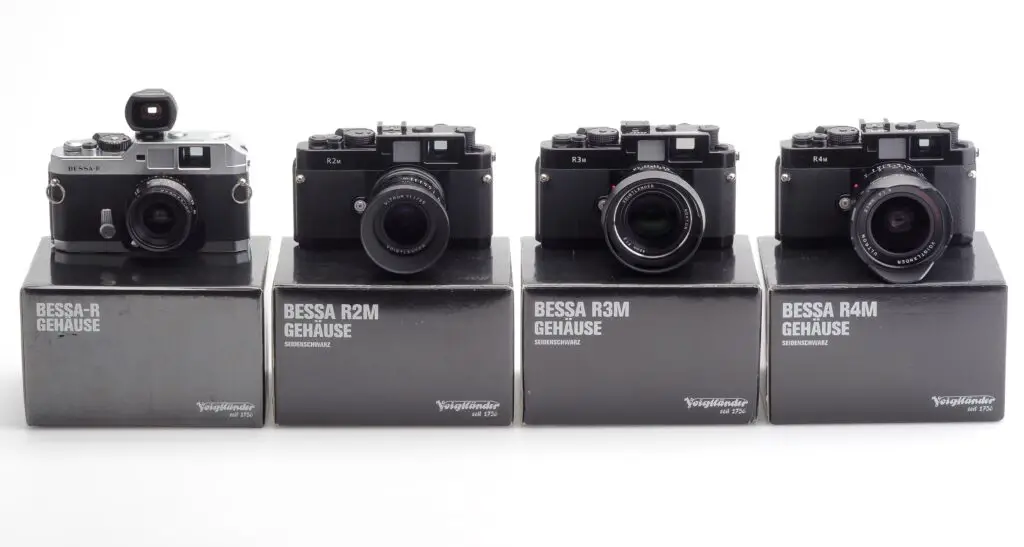
Although the histories of both the Rollei and Voigtländer brand names crossed paths in the past, I could not find any detailed information about how and why Rollei’s 2002 owners decided to work with Cosina to build a Rollei branded version of a Voigtländer Bessa camera.
However it happened, it happened and the camera in Cosina’s lineup which was chosen was the then top of the line Bessa R2. The Bessa R2 also made its debut in 2002 and was a significant update to the original Bessa R. Now featuring the Leica M-bayonet mount instead of the Leica Screw Mount, the R2 also had an all new and much sturdier magnesium alloy body with higher quality cast inner core, and overall better fit and finish. Compared to the original Bessa R, the Bessa R2 had the feel and build quality of a true premium camera.
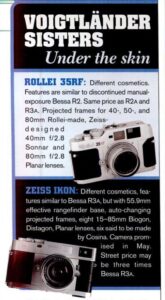
For Rollei’s version, most of the Bessa R2 was retained with a few exceptions. The most obvious is the satin silver aluminum body instead of the black or olive painted body of the Bessa. A noticeably thicker gray rubber body covering gave the camera a more premium feel and improved handling while shooting. One final change was that the normal “kit” lens included with the Rollei 35 rangefinder was a 40mm f/2.8 Sonnar lens built in Germany by Carl Zeiss, which was a recreation of the 40mm f/2.8 Sonnar lens offered on the top of the line version of the original Rollei 35. Although now using the Leica M-mount, and modern lens coatings, the lens of the new Rollei 35 rangefinder was very similar to the original one. In order to accomodate a 40mm focal length, a change to the frame lines visible inside of the viewfinder from 35mm in the Bessa R2 to 40mm in the Rollei 35.
Upon its release, the Rollei 35RF likely generated a lot of fanfare for its good looks and capable build quality and feature set. The release of an all new 40mm f/2.8 Sonnar lens using the Leica M-mount likely also raised a few eyebrows. In various articles I’ve read online, including the camera-wiki page for it, it says that the camera had a much higher price, and that the photographic world did not take well to a camera that was so obviously a Cosina. While this is certainly possible, I’ve found no evidence of it in archived issues of Popular Photography and American Photo in Google’s Book archive.
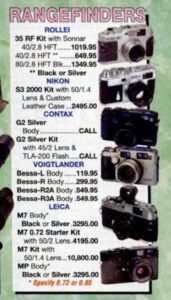
In fact, I’ve found very little about the camera at all, not even an original MSRP. A few promotional pages created by Rollei listing the cameras specs also does not list a price. The only time I found a price at all was in a back page ad from B&H from August 2005 which listed the camera with 40mm Sonnar lens for $1019.95. The same ad lists the 40mm Sonnar lens separately for $649.95 and a Bessa R2A body for $549.95. These prices when adjusted for inflation compare to $1595, $1015, and $860 respectively. So while these prices are still generally pretty high, they at least suggest the Rollei and Bessa versions of similar cameras sold for close to the same price.
Even if we don’t know the actual list price of the camera when it first went on sale, it does seem pretty likely that the camera only generated lukewarm sales. Other sites reference the camera being sold at a steep discount still new in box on store shelves in 2006, four years after its release.
While the Rollei 35RF certainly wasn’t a bad camera, it does seem likely that the people who decided to make it misjudged the market for a upgraded version of a premium camera. Further adding to its struggles (or perhaps as a result of), Rollei’s ownership would change once again in 2004 as Rollei Fototechnic GmbH sold off its manufacturing to Rollei Produktion GmbH, likely ending any hope of a follow-up or continued development of the original model.
Rollei’s struggles would continue in the years to come as the rights to the company would go in and out of bankruptcy, merges, splits, buyouts and a variety of other corporate sounding terms. Rollei still exists today under the name Rollei GmbH & Co. KG as a maker of a variety of photographic related products. As of January 2024, their website lists lenses, flash equipment, tripods, remote shutter releases, and even selfie-sticks as products in its portfolio. Their website lists a contact phone number with a German country code, suggesting that is where they are based and maintains a corporate history dating back to 1920 with images of original Rolleiflex TLRs.
Today, speak the name Rollei and most photographers still hold the brand in high esteem. The almost constant turmoil over the past 50+ years has done little to tarnish the company’s reputation as its TLRs and later medium format products are still desirable on the collector’s market. Although the Rollei 35 RF isn’t a true German Rollei, it shares a similarly positive reputation of other Cosina built rangefinders from the early 21st century, and as a result of its good looks and rarity, is a prized collector’s item. As a user, the camera is still new enough that most examples should be in good working order, and with support of the entire Leica M-mount, is a capable photographic tool.
My Thoughts
Lately, I’ve been unintentionally exploring some of the most desirable rangefinder cameras made over the years, wondering what the pinnacle of that format ever was. Since rangefinder development was essentially frozen in time with the rise of the SLR in the 50s and 60s, Leitz was really the only game in town when it came to new and exciting 35mm rangefinder cameras.
But if you look past the extremely excellent Leica M-series, there were other companies releasing new screw and bayonet mount rangefinders. I’ve looked at several Canon models like the Canon 7, the Yasuhara 一式 T981, and even the Cosina built Epson R-D1 digital camera, each of which offer new features and changes to the original Leica formula.
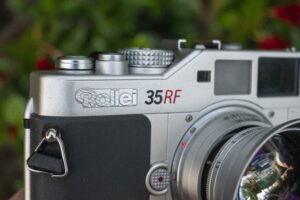
Until now however, I haven’t yet looked at a non-Leica made Leica M-mount film rangefinder. The most famous ones out there were the Bessa cameras made by Cosina in the early 21st century, and while any of those cameras would be worthy additions to my review queue, I decided to go with a lesser known, but equally capable camera, the Rollei 35RF. Like the Bessas, this camera has the name of a prestigious German marque, yet is made in Japan to a very high quality standard. The Rollei 35RF is a variant of the Bessa R2, but has a few changes.
In terms of tactile feel, the Rollei 35RF is very good, but not perfect. The body is made of die cast aluminum with a silver matte finish that hides fingerprints and offers good grip. The front and sides of the camera have a thick dark gray leather grip, which makes handling the camera easy. The grip isn’t very deep like you’d see on an SLR, but offers much better handling than classic rangefinders. The rubber grip does not extend all around the entire back of the camera as more than half of the door has the matte silver finish.
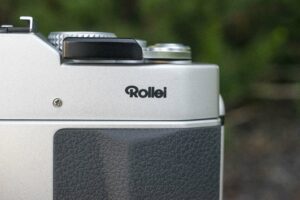
When this camera first went on sale, it came with an exclusive Rollei Sonnar 40mm f/2.8 HFT lens which initially couldn’t be purchased by itself. The 40mm f/2.8 Sonnar is said to be based off the 40mm f/2.8 Sonnar offered in the original Rollei 35 film camera from the 1970s. All the information I’ve read just says it is “based on” but doesn’t clarify whether it is an identical copy, however. At least two other Rollei exclusive lenses were announced, including a 50mm f/1.8 Planar and a 80mm f/2.8 Planar. Sadly, when I came across this camera, none of these lenses were paired with it. The 40mm focal length is one of my favorites to shoot, so I would have loved the opportunity to try it out, but instead I went with an equally impressive lens in the 50mm f/1.3 MS-Optics Sonnetar, which is a variation of the original Sonnar.
Despite what the promotional materials describe as an all metal body, the Rollei 35RF isn’t very heavy. Without a lens, the body is only 445 grams, which is about 130 grams lighter than a Leica M6 body and nearly identical to a Leica IIIg body. Some parts like the tip of the wind lever, viewfinder frame, and a few other touch points are plastic, which likely contribute to a camera weighing less than its appearance would suggest.
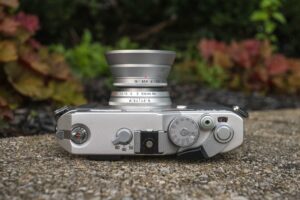
Most of the overall design of the Rollei 35RF is identical to that of other Cosina/Voigtländer Bessa rangefinders, which shouldn’t be a surprise as this camera is based off the Bessa R2. Up top, on the left is the rewind crank with folding handle. The left edge has a downward angle to it which the handle tucks in nicely keeping it nearly flush with the top plate when not in use.
Next is a three position selector which controls the projected frame lines seen in the viewfinder. This is one area in which the Rollei 35RF varies from the Bessa R2 in that it has a position for 40mm instead of 35mm. The difference is negligible, but necessary for the 40mm f/2.8 Sonnar kit lens that this camera usually came with. The two other positions are for 50mm and 80mm. Since the Rollei 35RF uses the Leica M-mount any lens of that mount in any focal length can be used with the camera, but you’ll need to use an auxiliary viewfinder for anything other than those three focal lengths.
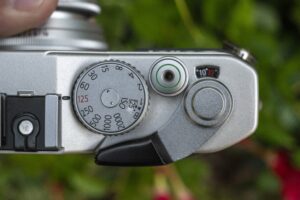
In the very middle is the flash hot shoe, one side of which is engraved with the camera’s serial number. Next to that is the combined shutter and film speed dial with shutter speeds from 1 to 2000 plus Bulb. Each setting has a prominent click stop which allows changing of shutter speeds with the camera to your eye quite easy. The shutter speed dial can be rotated a full 360 degrees, which means you can go from Bulb straight to 1/2000 without having to rotate it the entire other direction. Film speeds are changed by lifting up the outer edge of the dial and rotating the disc showing ISO film speeds in a small window next to the 1 second shutter speed from ISO 25 to 3200.
Above and to the right of the shutter speed dial is the cable threaded shutter release, then automatic resetting exposure counter, and finally the film advance lever. The exposure counter is additive, showing the number of exposures taken on a new roll of film, and the advance lever has a very short throw which requires what I would estimate to be a 100 degree throw to full advance the film and cock the shutter. Although I do appreciate the quickness of the film advance lever, this is one area in which the camera doesn’t live up to its German namesake standards. Comparing the film advance on a real Leica rangefinder to this Cosina built one, the lever has a tiny bit of wiggle and just doesn’t feel quite as high quality.
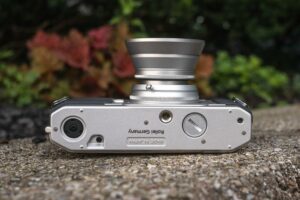
Flip the camera over and on one side is the coupling for the optional Rollei trigger winder which was also available on the Bessa R2. This optional winder is not motorized, but instead is a trigger winder, similar to the Leicavit or the design of the Canon VT-Deluxe. Next to the motor coupling is a plastic rewind release button, behind the lens mount is a metal 1/4″ tripod socket, then the opening for the battery compartment, and finally a divot near the edge which is used as a locating pin for the motor winder, to keep it from moving around. Curiously, in the center of the base plate is are the words “MADE IN JAPAN”, which immediately below is silk screened “Rollei Germany”. The close location of both the words “Japan” and “Germany” almost feels like someone was compensating for something! 🙂
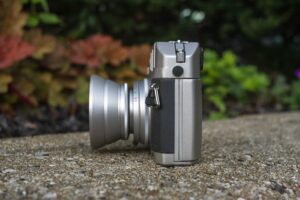
The left side of the camera has a PC flash sync port just below the tip of the rewind handle when folded shut. Opening the film compartment is done by tugging up on the rewind handle, so there is no door latch on either side of the camera like you’d expect to see on a classic rangefinder. Both sides of the camera have forward angled metal strap lugs. The forward angle to these lugs allow for better balance while the camera dangles from your neck with a heavy lens attached, to prevent it from tilting forward.
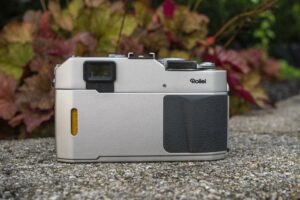
Around back the film door has a film cassette window for reading the type of film loaded in the camera, and opposite is the thick rubber grip I previously mentioned. The grip has an additional raised hump which is perfectly located where your right thumb rests while holding the camera, adding additional reassurance and comfort to its hold. The plastic frame around the eyepiece for the viewfinder is slotted for use with viewfinder accessories, and opposite the viewfinder on the back of the top plate is a silk screened Rollei logo, making it the third place on this camera that says Rollei.
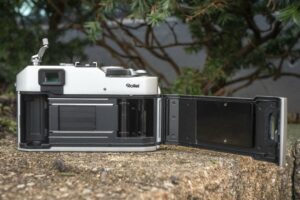
Opening the right hinged film door reveals a rather ordinary looking film compartment. Despite being made in the 21st century, the Rollei 35RF doesn’t support DX film coding, so there are no contacts in the area where a cassette goes, and since no accessories like a date back were offered, there are no connections for that. The film compartment is almost entirely finished in a flat black paint, with the exception of twin film rails above and below the film gate.
Film transports from left to right onto a plastic and multi-slotted film take up spool. There is no quick or automatic loading film system, but with multiple slots in the spool, you really don’t need it. The film pressure plate is black painted metal with many little divots in it to reduce friction as film passes over it. The door channels above and below the film gate are deep and do not contain any sort of light seal material, which means nothing to rot out, however a foam seal is present both on the door hinge and around the clear film peep hole in the door. This camera, having been made only 20 years ago still had its foam in good condition, showing no signs of rot, but I suspect as these cameras continue to age, they will eventually need to be replaced.
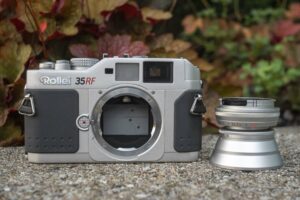
Up front, the two tone silver metal body and gray grip gives the Rollei 35RF an attractive look. In addition, the raised chrome metal Rollei logo and silk screened black and red 35RF add a touch of color to the front, giving a bit of sophistication that the monochrome Voigtländer Bessas don’t have. Along top are the small rangefinder window, frosted brightline window and main viewfinder window. To the left of the lens mount is the lens release button with red dot in the center, as you’d expect to see on any camera with the Leica M-mount.
Removing the lens is very fast and easy. A press of the button and a very short clockwise turn removes the lens. Installation is the opposite of removal, but doesn’t require the use of the button. The total rotation of the lens from installed to removed is much shorter than most bayonet SLR mounts. I could not find the angle of rotation needed, but to the naked eye, I would guesstimate about 30 degrees.
With no lens attached, you can see gray shutter blades which are painted that color because the TTL exposure meter takes a reading off light reflecting onto the shutter itself. With no lens attached, if you look at the underside of the top of the opening, you can see the meter pointing down at an angle toward the blades. Unlike cameras like the Leica M5 in which the exposure meter is mounted to an arm and moves in and out of position to take a reading, Cosina’s system is much simpler, and probably more reliable because it doesn’t have to keep moving out of the way.
An optional accessory for the Rollei 35RF is a bottom trigger “quick winder” called the Rollei QW35. This accessory screws onto the bottom of the camera using the tripod hole, extending the bottom of the camera by a little more than half an inch. With it installed, advancing film and cocking the shutter is done via a folding handle. While holding the camera in shooting position, fold the handle so it sticks straight down, and with your left hand, grip the handle and pull it to the left. One single motion is enough to full advance the film and cock the shutter. Although this isn’t quite as fast as an electric motor drive, it is quite fast, and comfortable to use.
With the QW35 installed, you have access to two sets of 1/4″ tripod socket, one which still allows you to advance the film with the camera on a tripod, and one in which you cannot. With the QW35 mounted, the top film advance lever still functions as normal. There is also a rewind release button, however you do not have access to the battery compartment.
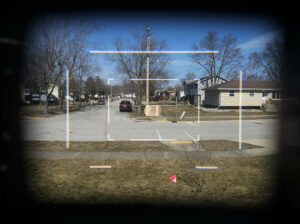
There is a lot to like about the Rollei 35RF, but for me, the best part of this camera is its viewfinder which is extremely large and bright, offering an extremely clear and easy to see rectangular rangefinder patch and adjustable frame lines. To be fair, with the exception of the 40mm frame lines unique to this camera, the rest of the viewfinder is exactly the same as other Cosina built rangefinders, and likely as good as the ones on the Leica M-series. But what good company to be in, as these are some of the best rangefinders made on any camera ever. I suspect if you could go back in time to the 1930s when 35mm rangefinders first became popular and showed this camera to someone back then, their head would spin.
Changing the frame lines using the dial on top of the camera show dedicated 40mm and 50mm framelines. In the 80mm position, a third set of frame lines do appear, but at the same time as the 40mm ones. Regardless of which framelines you are using, all three automatically correct for parallax, which means they move down and to the right when focusing up close to correct for the difference in location of the viewfinder and the lens.
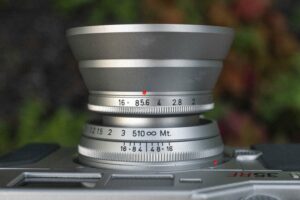
The Rollei 35RF is an entirely mechanical camera and works fine with no batteries, but if you want to utilize the TTL SPD meter you’ll need two fresh batteries installed. With power to the meter, one of three red LEDs will display near the bottom of the viewfinder, a left arrow to indicate under exposure, a circle to indicate proper exposure, and a right arrow to indicate over exposure. Compared to a similar feature on the Yasuhara T981 35mm rangefinder which was built around the same time as the Rollei 35RF whose LEDs are extremely difficult to read in bright light, the ones in the Rollei are much brighter, and in a location that make them easier to see outdoors. The metering system is coupled to the shutter speed, and since rangefinder lenses have no need for an “always open” diaphragm like SLRs do, the light passing through the lens is also taken into account, offering full metering control over shutter speed and f/stops.
There is a ton to like about the Rollei 35RF, and while I can’t claim that I’ve used every single premium 35mm rangefinder ever made, I have used enough of them to declare this to be a very, very good camera. I wish I had one of the 40mm f/2.8 Sonnar lenses that it originally came with, but they’re out of my budget. Still, with a 50mm lens mounted, an apples to apples comparison is still very reasonable but of course there’s only so much you can learn by playing with an empty camera. It is time to load in some film and shoot it!
My Results
If you’ve read this site long enough, you’ve heard me say certain things over and over, probably to the point that if someone ever created an AI version of Mike Eckman’s reviews, it would likely be able to recreate something that sounded pretty authentic, just based on the things I say over and over. One such thing is how much I love Kodak Panatomic-X. A black and white panchromatic film made from the 1930s to the 1990s and available in speeds of ASA 25 or 32, this film is not only gloriously sharp with the perfect balance of contrast and shadow detail, while also having little to no grain. If that wasn’t good enough, Panatomic-X is also notable as being time travel film, as no matter how expired or poorly stored a roll is, it almost always turns out great, even when shot at box speed. The worst thing about shooting Panatomic-X is that supplies get harder and harder to find every year, and I am convinced that the more I keep praising it, the more other people buy the remaining supplies out there.
That said, for the first roll through this Rollei 35RF which I was pretty confident was in good working order, I chose one of my precious factory rolled ASA 32 rolls (as opposed to the bulk stuff I have), and loaded it up. Combined with an ultra sharp, and fast f/1.3 lens with a body featuring an accurate meter, I figured I’d get some great shots. Before developing that roll, I had so much fun shooting the Rollei, I loaded in a roll of run of the mill Fuji 200 color…yawn…
If I had more time (and was better at measuring lens stuff), I could write two reviews in one here, as the quality of the MS-Optics Sonnetar 50mm f/1.3 are excellent. The story behind MS-Optics lenses is that they were designed by a man named Miyazaki Sadayasu who in 2006 formed his own optical company with the intent of creating his own lineup of lenses based on, but not entirely identical to classic lenses of the past. As the name suggests, the Sonnetar is a variation of the Zeiss Sonnar lens, but with a slightly faster f/1.3 maximum aperture. Since I want to keep this discussion primarily on the Rollei 35RF, you can read a very thorough and excellent review of the lens here. Needless to say, the lens does not disappoint.
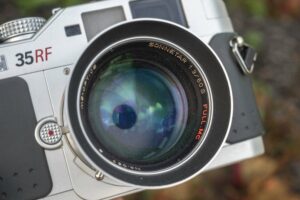
The Sonnetar is a well built lens with an all metal body and a large front glass element with built in hood. Although it does not cosmetically resemble any Zeiss lens I’ve seen, it certainly has the feel of a lens by an “A-tier” lens maker. Contrast and sharpness across the frame and corner to corner was excellent. Combined with the very fine grain structure of the Pan-X, the image took on an almost digital look to it. Although the images I got with the Fuji 200 film were good as well, I definitely appreciated the contrast and overall look of the black and white images better. I noticed no vignetting in outdoor scenes and even in the few indoor shots where I opened the lens up wide, I found softness to be minimal. This is a lens that definitely deserves more attention on adapted to digital. If I can ever find the time, maybe I’ll write my own review of the lens tested on my Nikon Z5. Until then, I’ll just say the lens was a perfect match for the Rollei 35RF and by no way lessened the experience compared to if I had shot a more famous Leica M-mount lens.
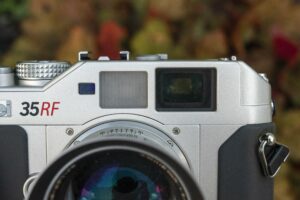
As for the camera itself, the Rollei 35RF lives up to expectations. Having never shot one of the original Cosina built Voigltänder Bessa film rangefinders, I had read enough of other people’s comments to have high expectations, which were met while shooting the Rollei. Without a doubt, the best part of this camera is the viewfinder. The extremely clear viewfinder is as bright and contrasty as any rangefinder I’ve ever used. The rangefinder patch is large and easy to see in all but the dimmest shooting situations. I had no issues getting razor sharp focus on every image I shot, even those indoors such as the ones of the workers at the gyro restaurant and inside the mausoleum. If you’ve never been a fan of rangefinder cameras because you found them difficult to use or hard to see, this is the camera (or another Cosina built one) for you. Yes, I realize Leica M-series bodies are just as good, and maybe even 1% better, but at triple the cost, the Rollei 35RF is a bargain compared to a Leica M-camera.
While talking about the viewfinder, I must also compliment Cosina on their implementation of the meter. I’ve shot other rangefinders with LED displays in them, and I don’t know if it is better light shielding or the location of the LEDs at the bottom of the viewfinder, but I never once had an issue seeing the display, even in the brightest light. In addition to an entire gallery of in focus images above, I also nailed exposure on every image using both the ASA 25 and 200 speed films.
The camera’s ergonomics are excellent. I found the weight and size of the Rollei 35RF to be ideal for my hand size and level of familiarity. Compared to some of my other favorite rangefinders, especially screw mount Leicas and Nikon rangefinders where I am not fond of the shutter release location, the one on the Rollei 35RF is not only ideally located, but large enough to locate with your right index finger immediately after picking it up. I would guess that anyone, having never handled a film camera of any kind, would be able to pick this camera up, and without any training, know exactly where its controls are. Even the MS-Optics lens, which is not a common lens/body pairing, feels like it was made this camera with easy to locate focus and aperture rings.
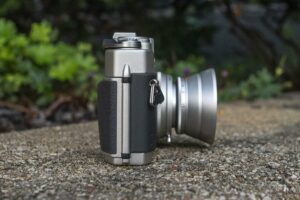
In addition to excellent ergonomics, I found the thicker rubber grips on the side, front, and back of the camera to be ideally located and with just the right amount of grip. While I’ll still recommend using a neck strap while using camera like this, even without one, I felt comfortable holding this camera without having to worry about it slipping from my hands.
There is so much to like about the Rollei 35RF that I am finding it very difficult to come up with any cons. The one I’ve come up with is only an issue for those of you who prefer discreet photography, which is that the action of the shutter firing is quite loud. The vertically traveling metal blade shutter in this camera is quite noisy, and much louder than any focal plane shutter Leica I’ve used. For many this won’t be an issue at all, but try to shoot this camera in a quiet church procession or library, and you might get ejected!
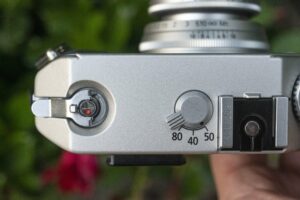
Beyond that, there’s little to complain about. If I could change anything about the camera to make it better, I would probably increase the diameter of the shutter speed dial and have it overhang the front edge of the top plate like on the Leica M5 and Canon EF, and maybe it would have been cool to have a fourth position of the adjustable frame lines to include something longer than 80mm, but I honestly don’t think I would ever use it.
I am going to honest folks, the Rollei 35RF is damn near perfect. Sure, it is a little loud and I don’t have the 40mm lens it was supposed to come with, so it effectively is the same as the Bessa R2, but I prefer the silver look and thicker rubber grip of this camera compared to the Bessa, so I can still say the Rollei version is marginally a better camera.
For anyone reading this review and feeling an immense sense of GAS, you might first balk at the price as excellent condition bodies currently start on eBay at between $600 and $800, but then I remember that Leica M6 bodies usually start at double that. Sure, maybe the German cameras have marginally better build quality, and are easier to get repaired, but is it really worth the price premium? Right now, my answer is no.
Considering the value compared to similar cameras, the excellent ergonomics, excellent viewfinder, excellent metering system, and overall excellent performance, this is an excellent camera and one of the best 35mm rangefinders I’ve ever used. Maybe some day I’ll get an original 40mm lens for it, but until them, this MS-Optics 50mm f/1.3 lens does just fine!
Related Posts You Might Enjoy
External Links
http://camera-wiki.org/wiki/Rollei_35_RF
https://elekm.net/pages/cameras/rollei_35_rf.htm
https://www.nocsensei.com/camera/tecnica/marco-cavina/marcocavina/rollei-35-rf/
https://www.macfilos.com/2021/02/15/retro-style-rollei-35-rf-with-sonnar-40-2-8/
https://www.photrio.com/forum/threads/is-the-rollei-35rf-a-good-deal.29472/
https://shige-art.net/en/rollei-35rf/
https://dustygrain.com/rollei-35-rf/
https://web.archive.org/web/20050305012118/http://www.rollei-usa.com/compact/35rf.htm (archived)

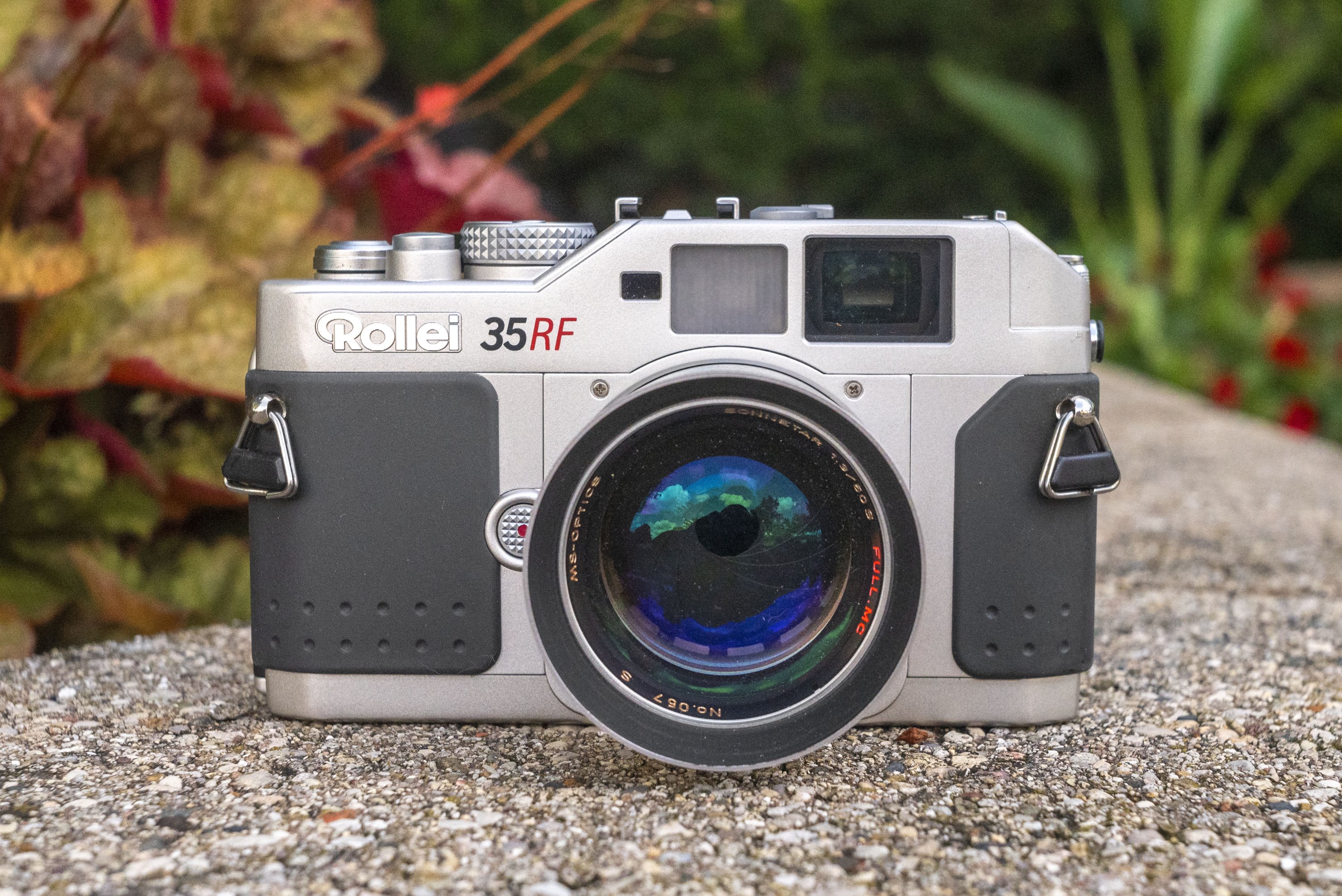
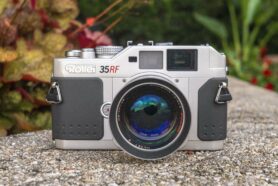
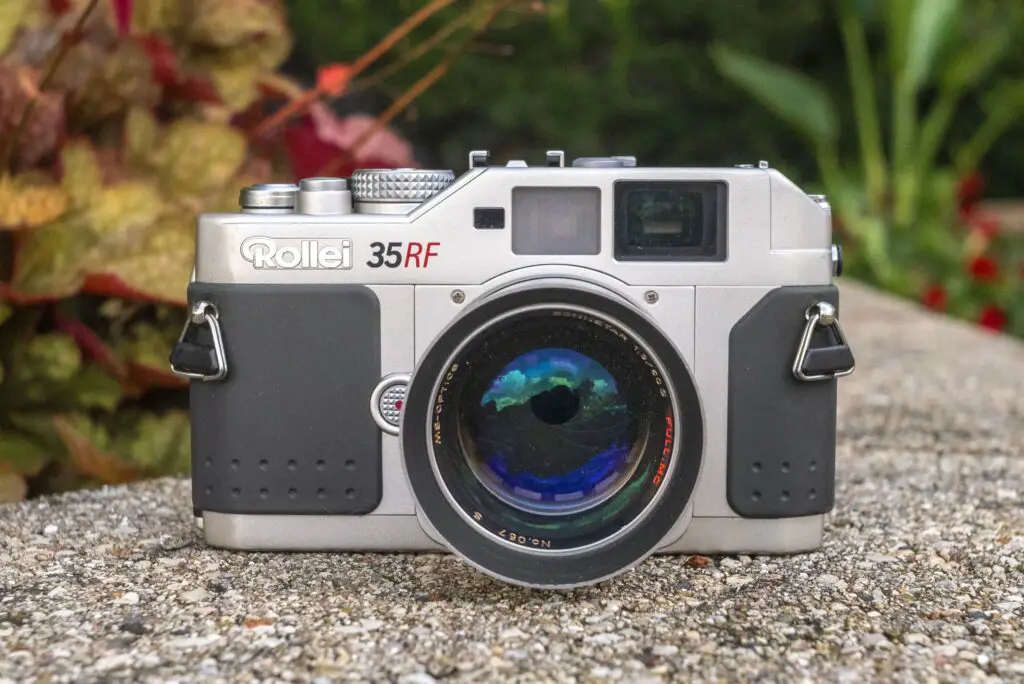
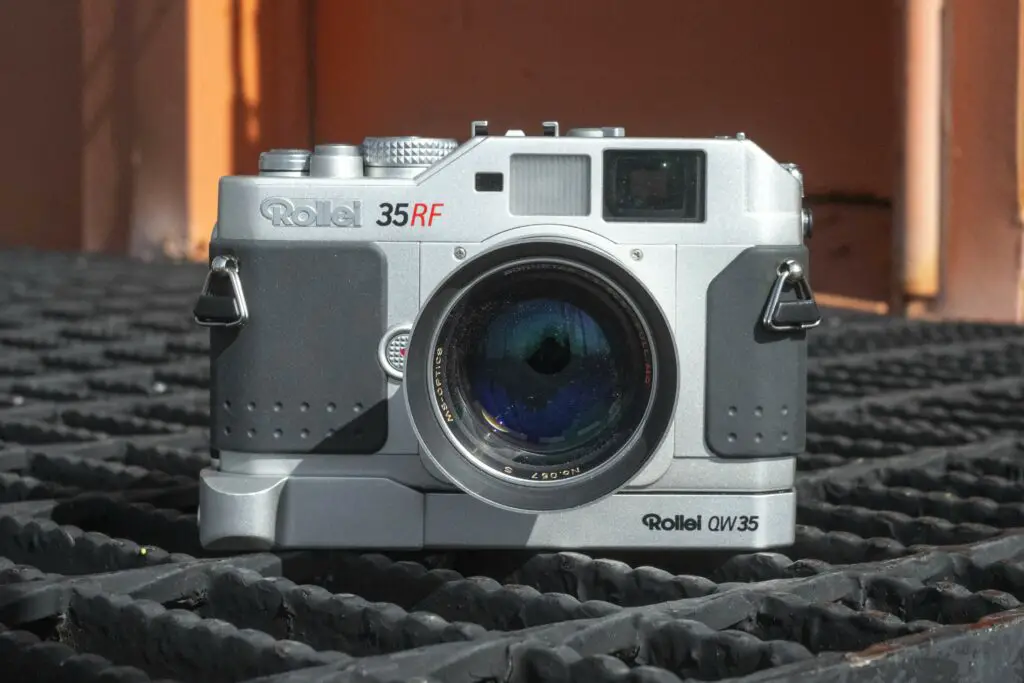
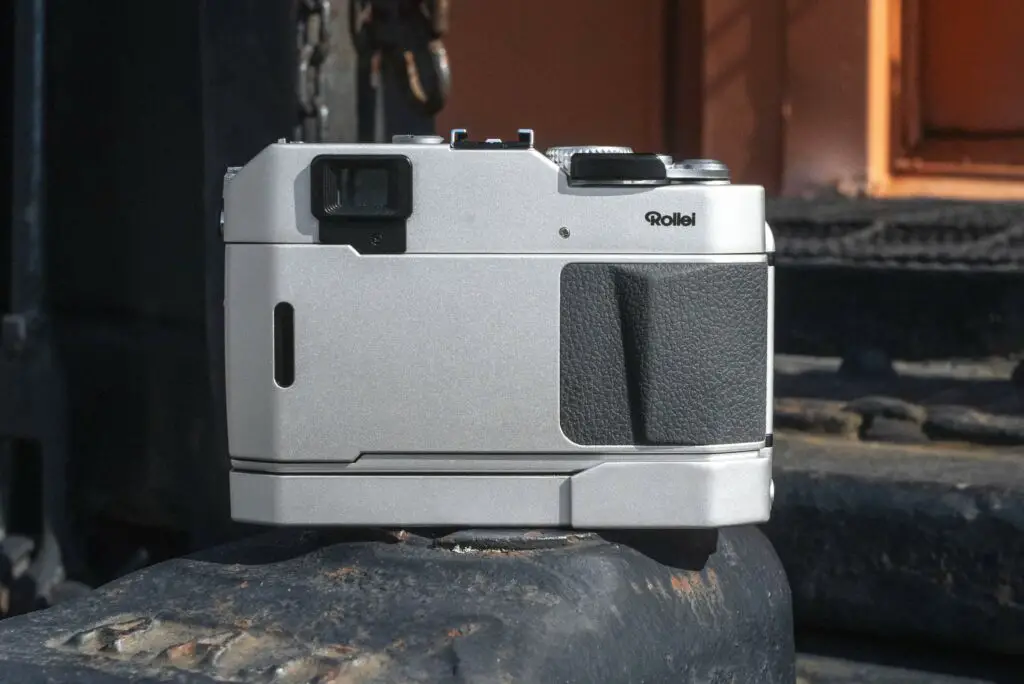





























Hi Mike:
The Rollei 35RF was tested in Popular Photography’s February 2004 issue on page 42. Its 40mm f/2.8 HFT Sonnar and 80mm f/2.8 HFT Planar lenses were tested on page 44. The test says the 35RF had a street (not list) price of $1900 with Sonnar 40mm f/2.8. The 40mm was $1200 in black, $1100 in chrome; the 80mm was $2550 in black, $2500 chrome.
As you’ve discovered, this issue is not in Google Books.
Thank you
paul1513
Very cool thanks for sharing! Do you have a scan of that article?
Hi Mike:
I found my paper magazine and have scans now!
paul1513
A most inveresting review here, Mike. This Bessa/Rollei is a sophisticated version of the p&s style Bessa-L; I owned one of those some years ago and shot it with either a 24mm or 28mm lens.
MS-Optics is a brand rarely seen in the US, which is unfortunate. Here’s a lengthy article about their product range: https://phillipreeve.net/blog/overview-ms-optics-lenses/